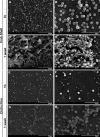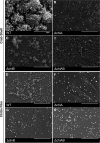Contributions of Francisella tularensis subsp. novicida chitinases and Sec secretion system to biofilm formation on chitin
- PMID: 19948864
- PMCID: PMC2805214
- DOI: 10.1128/AEM.02037-09
Contributions of Francisella tularensis subsp. novicida chitinases and Sec secretion system to biofilm formation on chitin
Abstract
Francisella tularensis, the zoonotic cause of tularemia, can infect numerous mammals and other eukaryotes. Although studying F. tularensis pathogenesis is essential to comprehending disease, mammalian infection is just one step in the ecology of Francisella species. F. tularensis has been isolated from aquatic environments and arthropod vectors, environments in which chitin could serve as a potential carbon source and as a surface for attachment and growth. We show that F. tularensis subsp. novicida forms biofilms during the colonization of chitin surfaces. The ability of F. tularensis to persist using chitin as a sole carbon source is dependent on chitinases, since mutants lacking chiA or chiB are attenuated for chitin colonization and biofilm formation in the absence of exogenous sugar. A genetic screen for biofilm mutants identified the Sec translocon export pathway and 14 secreted proteins. We show that these genes are important for initial attachment during biofilm formation. We generated defined deletion mutants by targeting two chaperone genes (secB1 and secB2) involved in Sec-dependent secretion and four genes that encode putative secreted proteins. All of the mutants were deficient in attachment to polystyrene and chitin surfaces and for biofilm formation compared to wild-type F. novicida. In contrast, mutations in the Sec translocon and secreted factors did not affect virulence. Our data suggest that biofilm formation by F. tularensis promotes persistence on chitin surfaces. Further study of the interaction of F. tularensis with the chitin microenvironment may provide insight into the environmental survival and transmission mechanisms of this pathogen.
Figures









Similar articles
-
Cyclic di-GMP stimulates biofilm formation and inhibits virulence of Francisella novicida.Infect Immun. 2012 Dec;80(12):4239-47. doi: 10.1128/IAI.00702-12. Epub 2012 Sep 17. Infect Immun. 2012. PMID: 22988021 Free PMC article.
-
Long-Term Survival of Virulent Tularemia Pathogens outside a Host in Conditions That Mimic Natural Aquatic Environments.Appl Environ Microbiol. 2021 Feb 26;87(6):e02713-20. doi: 10.1128/AEM.02713-20. Print 2021 Feb 26. Appl Environ Microbiol. 2021. PMID: 33397692 Free PMC article.
-
Chitinases are negative regulators of Francisella novicida biofilms.PLoS One. 2014 Mar 24;9(3):e93119. doi: 10.1371/journal.pone.0093119. eCollection 2014. PLoS One. 2014. PMID: 24664176 Free PMC article.
-
Chitin and Products of Its Hydrolysis in Vibrio cholerae Ecology.Biochemistry (Mosc). 2015 Sep;80(9):1109-16. doi: 10.1134/S0006297915090023. Biochemistry (Mosc). 2015. PMID: 26555464 Review.
-
Type II secretion and type IV pili of Francisella.Ann N Y Acad Sci. 2007 Jun;1105:187-201. doi: 10.1196/annals.1409.016. Epub 2007 Apr 13. Ann N Y Acad Sci. 2007. PMID: 17435117 Review.
Cited by
-
Francisella novicida and F. philomiragia biofilm features conditionning fitness in spring water and in presence of antibiotics.PLoS One. 2020 Feb 5;15(2):e0228591. doi: 10.1371/journal.pone.0228591. eCollection 2020. PLoS One. 2020. PMID: 32023304 Free PMC article.
-
Genome sequence and phenotypic analysis of a first German Francisella sp. isolate (W12-1067) not belonging to the species Francisella tularensis.BMC Microbiol. 2014 Jun 25;14:169. doi: 10.1186/1471-2180-14-169. BMC Microbiol. 2014. PMID: 24961323 Free PMC article.
-
Cyclic di-GMP stimulates biofilm formation and inhibits virulence of Francisella novicida.Infect Immun. 2012 Dec;80(12):4239-47. doi: 10.1128/IAI.00702-12. Epub 2012 Sep 17. Infect Immun. 2012. PMID: 22988021 Free PMC article.
-
Transcription Elongation Factor GreA Plays a Key Role in Cellular Invasion and Virulence of Francisella tularensis subsp. novicida.Sci Rep. 2018 May 2;8(1):6895. doi: 10.1038/s41598-018-25271-5. Sci Rep. 2018. PMID: 29720697 Free PMC article.
-
Treatment of bacterial biothreat agents with a novel purified bioactive lactoferrin affects both growth and biofilm formation.Front Cell Infect Microbiol. 2025 Jun 17;15:1603689. doi: 10.3389/fcimb.2025.1603689. eCollection 2025. Front Cell Infect Microbiol. 2025. PMID: 40599649 Free PMC article.
References
-
- Anda, P., J. Segura del Pozo, J. M. Díaz García, R. Escudero, F. J. García Peña, M. C. López Velasco, R. E. Sellek, M. R. Jiménez Chillarón, L. P. Sánchez Serrano, and J. F. Martínez Navarro. 2001. Waterborne outbreak of tularemia associated with crayfish fishing. Emerg. Infect. Dis. 7:575-582. - PMC - PubMed
-
- Balestrino, D., J. M. Ghigo, N. Charbonnel, J. A. Haagensen, and C. Forestier. 2008. The characterization of functions involved in the establishment and maturation of Klebsiella pneumoniae in vitro biofilm reveals dual roles for surface exopolysaccharides. Environ. Microbiol. 10:685-701. - PubMed
-
- Bartnicki-Garcia, S. 1968. Cell wall chemistry, morphogenesis, and taxonomy of fungi. Annu. Rev. Microbiol. 22:87-108. - PubMed
-
- Bassler, B. L., C. Yu, Y. C. Lee, and S. Roseman. 1991. Chitin utilization by marine bacteria. Degradation and catabolism of chitin oligosaccharides by Vibrio furnissii. J. Biol. Chem. 266:24276-24286. - PubMed
Publication types
MeSH terms
Substances
Grants and funding
LinkOut - more resources
Full Text Sources

